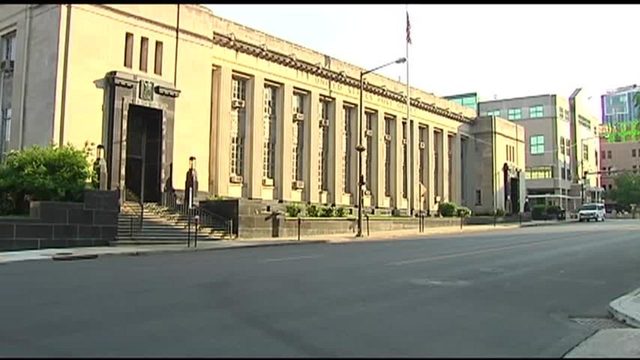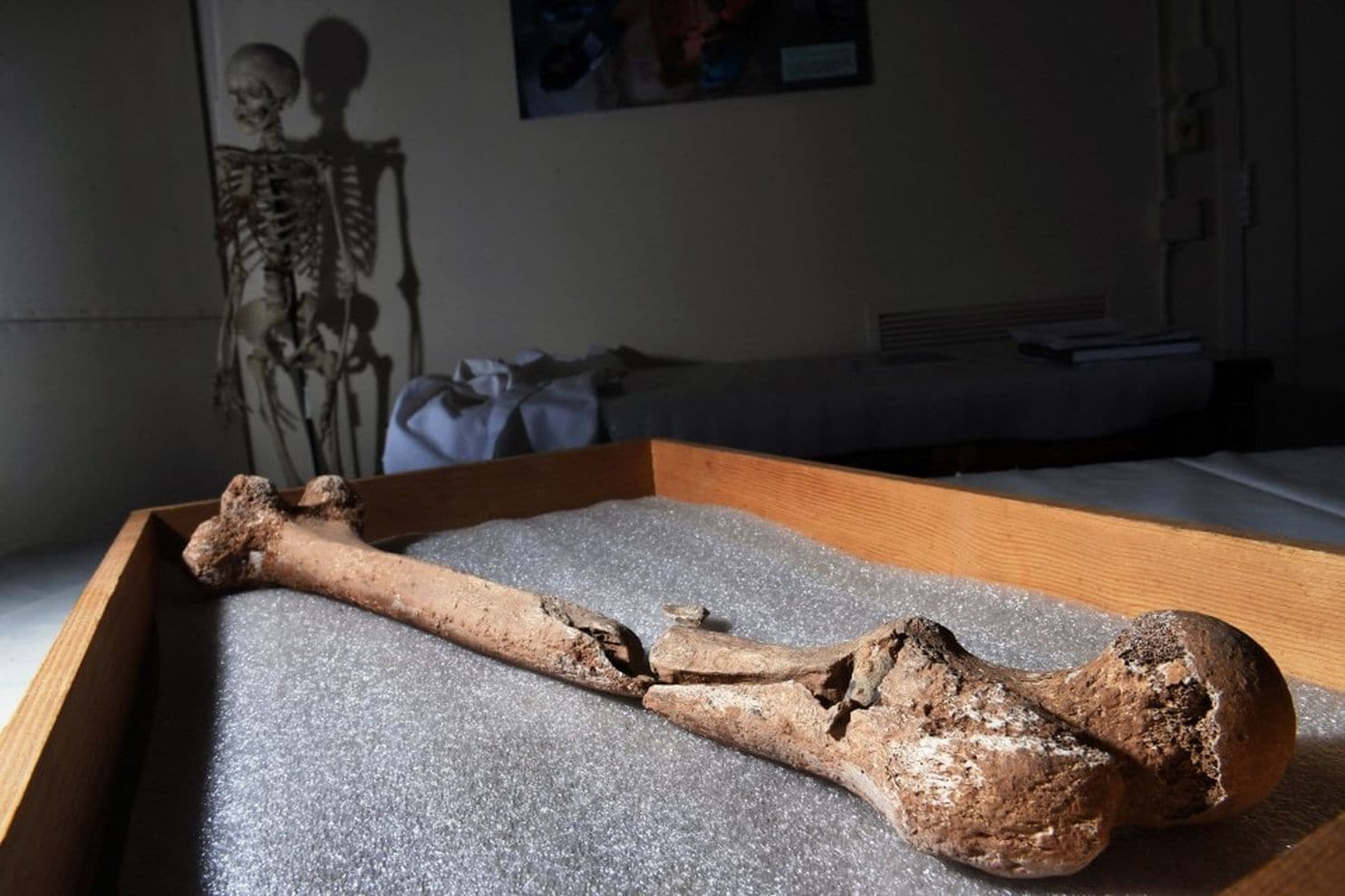Bones of Civil War dead found on a battlefield tell their horror stories
By Michael E. Ruane
June 20
Washington Post
The bullet probably hit the Union soldier as he was fleeing. It may have struck his cartridge box first, which sent it tumbling through the muscle of his right buttock, broke his right leg and buried itself sideways in his thigh bone just below the hip.
His buddies probably carried him as they retreated before the storm of Rebel gun and cannon fire. At the field hospital, the harried surgeons probably took a look at him and moved on to those less seriously wounded.
After he died, he was laid in a shallow pit with a dead comrade and the sawed-off arms and legs of as many as 11 more soldiers cut down at the Civil War’s Second Battle of Bull Run, in August 1862.
On Wednesday the National Park Service announced that archaeologists have found the “limb pit” where the two soldiers and the amputated arms and legs were buried.
The discovery, on the battlefield just north of Manassas, Va., is extraordinary, experts said.
Nothing like it has been found before, and a century and a half after the battle, when a Park Service archaeologist examined the fallen Yankee’s thigh bone, the bullet was still stuck in it.
“As an archaeologist . . . it’s exciting,” said Brandon S. Bies, who brought the bone out of the pit. “As a human being, lifting the leg of an American soldier and holding the bone with the bullet that killed him, it’s an emotional experience.”
Scientifically, it’s “one in a million,” he said. “But for that soldier, it wasn’t a good one in a million. It was the end of his life.”
The two soldiers — referred to as Burial 1, with the embedded bullet, and Burial 2 — were placed side by side in the pit. The severed limbs were carefully arranged next to them, like broken tree branches, according to a photograph from the dig.
Burial 1 probably went in first, because Burial 2 was partially on top of him.
The hole was about a foot deep, and over the years farm plows had carried off the skull of one man and part of the skull of the other.
Anthropologists from the Smithsonian Institution have studied the injuries suffered by the two soldiers and examined the cut marks on the severed limbs made by the surgeons’ saws. There were nine severed legs and two arms in all.
The identities of the soldiers are not known, and their fates were probably a mystery for their families, painful and enduring.
But scientific tests and circumstantial evidence show they were probably Northerners.
The bullet in the leg of Burial 1 was fired from an imported British Enfield rifle musket then commonly used by Confederates, said Bies, now the superintendent of the Manassas National Battlefield Park.
The Burial 1 soldier, who was probably in his 20s, stood about 5 feet 7 inches tall. No clothing was found with him.
The man in Burial 2 was laid to rest in his Union coat — its four eagle-imprinted buttons were found in the pit with him.
He was probably in his 30s, and only about 5-foot-5.
He had been wounded by one large ball that smashed his upper right arm, a smaller one that hit him in the groin and a smaller one that struck near his right shin. Several of the rounds were found in the ground near him.
The Park Service believes the men may have been hit during a doomed Union attack on Aug. 30 against Confederate forces hunkered down in an unfinished railroad cut at the top of a ridge.
“It’s so rare that you have a discovery like this,” said Smithsonian anthropologist Kari Bruwelheide. “You have a burial feature that speaks in so many ways to the events of a battle, but also to the . . . people participating in treating the wounded.”
The cost in lives and limbs was high.
The Second Battle of Bull Run was at that point the largest battle ever in the Western Hemisphere, Bies said, and involved almost 125,000 combatants.
It was fought Aug. 28 through 30, 1862, over much of the same ground as the First Battle of Bull Run a year before.
And the successful Confederate attack near the end “was the largest massed infantry assault on either side of the entire American Civil War,” Bies said.
“It was devastating,” he said. “The Union forces, they didn’t stand a chance.”
Roughly 1,700 Union soldiers and 1,200 Confederates were killed, and a combined total of more than 14,000 were wounded.
Amputation of a broken arm or leg was a common remedy, and surgeons worked feverishly with saws and knives.
Smithsonian anthropologist Douglas Owsley said the surgeon would stand on the wounded man’s right side. If a leg was being removed, the uninjured leg would be tied to the operating table. The soldier would be put to sleep with chloroform or ether. Medical aides might hold the soldier’s hands.
“It starts out with scalpels, and it’s going to ultimately progress to the bone saw,” Owsley said. “A good surgeon can do this in about 10 minutes or less.”
The result, after almost any combat, was the refuse of amputated arms, legs and feet. In one field hospital after Second Bull Run, doctors dropped limbs out a window into a grisly pile.
“It was an awful sight, and one that I have never forgotten,” a Union soldier remembered, according to John J. Hennessy, author of a book about the battle. “It had the appearance of a human slaughterhouse.”
For the man with the fractured leg and the embedded bullet, nothing could be done.
“That surgeon is triaging and he’s seeing who he can help and who he can’t,” Owsley said. “And he literally is going to say this man’s got such a high-up injury that the only way he can deal with it is to take . . . the thigh completely off, and he just can’t do it.”
It’s not clear who buried the soldiers and the limbs, or when. But it’s likely that it happened after the battle.
When the Union army fled, thousands of wounded men were left on the battlefield.
One of them was John S. Slater, an 18-year-old Union corporal from the 13th New York regiment who was hit in the throat and side during the attack on the railroad cut.
Days later, he managed to stagger to a field hospital outside the house of the “Widow Dogan,” he recalled years later. That was probably the Lucinda Dogan house that stands today.
There, in the shade of some trees, “the surgeons were at work at their bloody but merciful trade,” he recalled. He watched as doctors, using a door for an operating table, amputated the right arm of a Union soldier whose elbow had been smashed by an artillery shell.
He had declined anesthesia, Slater recalled, and after the severed arm was placed in a “ghastly heap of shattered limbs,” he asked to see it one more time to bid it farewell.
“He placed it . . . to his lips, kissed it, and saw it no more,” Slater wrote.
A ‘humbling’ sight
Evidence of the pit was discovered in 2014 during excavation for a utility line but was not fully examined until 2015, the Park Service said.
Initially, tiny bone fragments from the utility digging were taken to the Smithsonian’s National Museum of Natural History, where they were found to be human.
The Smithsonian’s Bruwelheide assembled pieces of what turned out to be a left thigh bone and noticed that it had been cut, as if in an amputation.
Further excavation was recommended, and the pit was subsequently located. (The agency will not disclose the exact location of the site.)
Additional research might reveal the two soldiers’ names. But identifying the owners of the severed limbs could be easier, because many surgeons kept records of whose arms or legs they were cutting off, the Smithsonian said.
Bies said that many of the men whose limbs were cut off may well have survived the war.
An experienced Civil War archaeologist, Bies was assigned to legislative and congressional affairs for the Park Service at its National Capital Region headquarters in mid-October 2015 when he got a call about some sort of a discovery on the Manassas battlefield.
“It wasn’t so much a ‘Guess what we found,’ as a ‘You’ll never believe what we found,’ ” he said last week, standing under a tree on the quiet field where birds chirped and the wind rustled the leaves.
He hurried through traffic to the site and found a rectangular pit partially exposing what was there.
“It was humbling,” he said. “You could see, standing above that as it was being uncovered, the horrific wounds, the one gentleman’s leg completely obliterated.”
Bies used a metal detector to check for artifacts. “You didn’t want to accidentally nick something,” he said. As he did, he got a hit near the broken leg that he suspected might be a bullet.
The team excavated around the broken leg, leaving it on a kind of pedestal of earth.
Then he gently raised the bone from where it had rested since 1862.
“It wasn’t until it broke loose from the dirt and was lifted into the air that you could tell that the bullet was embedded in the bone,” he said. “We never expected that. Never.”
The two soldiers will be the first burials in the new section of Arlington National Cemetery when it opens this summer. Their coffins will be built with wood from a downed tree taken from the battlefield.
The Park Service said it is still deciding what to do with the limbs.
Michael E. Ruane is a general assignment reporter who also covers Washington institutions and historical topics. He has been a general assignment reporter at the Philadelphia Bulletin, an urban affairs and state feature writer at the Philadelphia Inquirer, and a Pentagon correspondent at Knight Ridder newspapers. Follow @michaelruane










